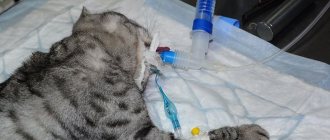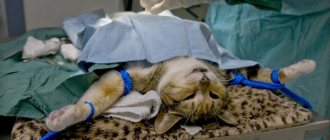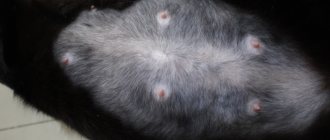Owners, when deciding to sterilize a cat, worry that their pet’s behavior will change. She will be withdrawn, unaffectionate, gain weight, and become lazy. However, there is not a single scientific study that would prove that a cat’s behavior changes in a negative direction after sterilization. On the contrary, castration reduces or completely stops irritability caused by hormonal surges during estrus, aggression in the struggle for “male” attention.
What effect does sexual behavior have on a cat?
Any cat, having reached a certain age, strives to procreate. Characteristic sexual behavior is an integral part of a cat's life. And it is impossible to influence sexual heat or estrus without medication or surgical intervention.
Some owners associate their pet's behavior during heat with her character. And then the animal is credited with such traits as a tendency to wander, aggressiveness, and vindictiveness, because it pees anywhere.
There is an explanation for everything:
- Cats allowed to go outside are accused of straying. But they leave for several days to have offspring. Animals are guided by instinct.
- The screams that irritate owners so much are not a bad character, but an attempt to call for a male, because the cat herself cannot leave the apartment.
- Hormonal surges make the cat aggressive. In nature, aggression is a useful mechanism by which a female increases her chances of mating compared to competitors. But while in an apartment, a cat is capable of unexpectedly showing aggression towards any object that provokes it - a person, another animal.
- Puddles of urine in the most unpredictable places are not revenge or “to spite” the owner. These are marks by the smell of which the male will quickly find the female.
Therefore, most often “bad” behavior is not the result of habits, but the implementation of the cat’s instinct to reproduce. She "should" do this. This is how nature intended it.
Doctors, when talking about the best age for sterilization, promote the operation more before the first heat. Because in this way you can avoid characteristic behavior during sexual hunting. The female will not scream or mark because she has no interest in the opposite sex. Accordingly, the behavior and character of the cat will not change after castration.
Cat behavior on the first day after surgery
Each “four-legged patient” recovers from anesthesia differently, so veterinary control and care is very important. It is better to take her home only when the animal’s behavior is close to her usual behavior.
After recovering from anesthesia, she poorly coordinates her movements, cannot stand on her paws, and may exhibit aggressive behavior.
Without being responsible for her actions, the cat can bite and scratch herself; it is strictly forbidden to allow children near her during this period; you need to spend as much time with her as possible.
Does a cat's personality change after sterilization?
Owners of cats who have already outgrown their first heat, have become adults, and may have already given birth, are primarily concerned about how the character of their pets changes after sterilization. Do they become less affectionate? Experts say the animal’s character will not change.
When a cat is in a state of heat, its behavior is largely controlled by the main “love” hormone – estrogen.
A cat can be especially affectionate. After the operation, the hormonal levels are stable, there are no surges, so the animal behaves calmer and more restrained.
How to prepare a cat for sterilization
Sterilizing a cat requires preliminary preparation. Except for clinical cases, the animal must be absolutely healthy. This is especially true for vaccinations and antiparasitic treatment.
Vaccination must be carried out at least a month before surgery. It significantly reduces the risk of developing infectious complications in the postoperative period, when the pet’s immune system is weakened. In the absence of vaccinations, before the intervention, the cat is given a serum injection, which ensures stable functioning of the immune system over the next 14 days. Anthelmintic measures are carried out at least 10 days before sterilization.
Preparatory measures also include:
- laboratory tests of urine and blood;
- ultrasound examination of the reproductive organs;
- cardiogram.
At the discretion of the doctor, X-rays, respiratory examinations, and others are additionally prescribed.
Important: immediately before surgery, the animal must be limited in food (8-12 hours before) and water (3 hours before).
You should take care in advance about the carrier in which the cat will be transported from the clinic to home. Additionally, you will need an absorbent diaper in case of involuntary outflow of urine, as well as a sheet or blanket to prevent hypothermia.
Examination of a cat before sterilization
How sterilization methods affect behavior
It is widely believed that the term "castration" refers to the operation on males, and "sterilization" on females. This is wrong. Because castration, regardless of gender, means the complete removal of reproductive organs. And sterilization in the case of cats is a tubal ligation (vasectomy). But more often the term “sterilization” has become established in everyday life, although this means castration.
With tubal ligation, the animal will not become pregnant, but sexual behavior during the period of estrus remains. Such an operation is now rarely performed. However, if a vasectomy was performed, then the owner should not be surprised that after sterilization the cat became aggressive or exhibits increased excitability, or began to dominate other animals in the family, and is more often exposed to stress. Thus, this sterilization method does not solve behavioral problems.
In addition, after a vasectomy, the risk of diseases of the genitourinary system and cancer is high.
In veterinary medicine, castration is considered the safest, which is carried out in 2 ways:
- Ovariectomy – removal of the ovaries. It is practiced less and less due to the high risk of complications.
- Ovariohysterectomy - removal of both the uterus and ovaries through an incision or using laparoscopy.
After ovariohysterectomy, the cat completely loses interest in the opposite sex, due to which it becomes calmer and more balanced.
But you should understand that changes in hormonal levels do not happen overnight, it takes time. Some animals require up to a month, others more.
What is cat sterilization, main types
In everyday life, sterilization is understood as an operation as a result of which the cat’s sexual instinct disappears.
Due to some confusion in the terms “castration” and “sterilization” (in the first case, all reproductive organs will be removed, and the second implies limited manipulation), in what follows we will talk about sterilization of a cat as a general concept. Pregnancy can be prevented in cats by surgical and chemical methods. Among the operational effects, the following types of sterilization are distinguished:
Cat sterilization surgery
- removal of the ovaries (used if the cat has not given birth);
- removal of the ovaries and uterus (used for individuals who have given birth, as well as for medicinal purposes according to indications);
- removal of the uterus (rarely performed, since the production of hormones and corresponding behavior are preserved);
- ligation of the uterine tubes (also rarely done, due to the preservation of hormone levels and the development of complications).
An alternative method of surgical intervention is the use of hormonal chemicals in the form of drops, tablets or injections. Depending on the amount of the active ingredient and the composition of the products, they can suppress the sexual instinct for 1 to 6 or more months.
Most veterinary specialists advise resorting to surgery once, rather than giving the cat hormonal drugs throughout its life. This is due to lower financial costs and fewer complications.
Attention: frequent use of hormonal drugs threatens the development of oncological pathologies, digestive, neurological and endocrine disorders, and in the event of pregnancy - congenital anomalies of the fetus, miscarriages.
A cat after sterilization asks for a cat
The biggest surprise for owners after sterilization is the sudden onset of signs of heat in their pet. How is that possible, since that’s why the operation was performed?! There are several reasons for going into heat after castration:
- A “poorly performed” operation. If during the operation the ovary, even part of it, was left behind, it continues to produce hormones that put the female in a state of heat. This phenomenon is called “reminent ovarian syndrome.” Unfortunately, the situation can only be corrected through surgery. For this purpose, abdominal surgery is performed. Laparoscopy (penetration through a puncture) is not effective in this case.
- Castration in heat. In some cats, heat is prolonged or does not stop at all. This condition is an indication for sterilization during heat. In such animals, the hormonal levels do not stabilize immediately after surgery. Therefore, signs of estrus persist for some time.
- Hormonal duplication. Quite rarely, however, it happens that after removal of the ovaries, another endocrine gland (adrenal glands, pituitary gland, hypothalamus, thyroid gland) takes over their functions. Moreover, this condition can develop in both sterilized and unsterilized animals and is most often observed at the age of 5-8 years.
- Diseases of the endocrine glands should not be discounted. First of all, various tumors that can seriously affect hormonal levels and sexual activity.
In any case, if signs of estrus are observed after sterilization, it is necessary to undergo examination at the clinic (ultrasound, blood tests for hormones).
Features of sterilization of cats for different body conditions
Sterilization of a cat must take place in accordance with certain requirements for its age and hormonal status. However, there are situations when there is a need for surgery during pregnancy, estrus and other conditions. The owner must know in what cases this is permissible and what the dangers are.
During heat
Removal of reproductive organs during this period is not recommended, since a sharp change in the hormonal levels of the cat’s body will negatively affect its future health. The recovery period will also be longer and more difficult; the risk of developing postoperative complications increases.
Veterinary experts recommend sterilizing a cat a week after the end of estrus and no later than 2 weeks before it starts.
During pregnancy
Sterilizing a pregnant cat is also fraught with negative consequences. It is justified only in the following cases:
- abnormal development of fetuses;
- a cat disease caused by pregnancy that threatens its life;
- the animal is not able to bear kittens due to health conditions or age.
After childbirth
Sterilization of cats after birth must be carried out in accordance with certain rules:
- if the pet does not feed the kittens, you should wait about a month;
- if the cat is nursing, then you will need to wait 2 to 3 months after giving birth.
The most suitable time to sterilize an animal after lambing is 60 days. During this period, hormonal levels will normalize, the uterus will acquire its normal size, and blood circulation in the pelvis will be restored.
The following situations may be indications for emergency sterilization immediately after childbirth:
- uterine rupture during the birth of kittens;
- neoplasms of the reproductive organs discovered during gestation;
- abnormalities, damage to the placenta;
- the presence or threat of severe postpartum bleeding.
While feeding kittens
As in the previous case, sterilization of a nursing cat is done only for certain indications. In addition to the above, it is possible to carry out an operation at the request of the owner if the death of newborns has occurred and the mother still has milk. Or, if the animal is used to walking outside, the cat can become pregnant even while feeding. Such situations are a common reason why owners cannot “catch” the necessary period of time to sterilize a reveler.
Cost of sterilization of cats
The price of cat sterilization is influenced by several factors:
- pricing policy and level of the veterinary clinic;
- type of operation;
- operating conditions (suture material, anesthesia, etc.);
- complexity of surgical intervention;
- postoperative period (care in the clinic, administration of additional drugs, complications, intravenous feeding, etc.).
On average, sterilizing a cat costs from 1,200 to 5,000 rubles.
Is it possible to sterilize a cat for free?
Sterilization of cats is not a mandatory, socially necessary veterinary service. However, many cities periodically hold promotions where stray cats can be sterilized for free. In addition, in some clinics, for certain reasons (they recently opened, the staff lacks experience, as advertising), prices for this service are reduced to 400-500 rubles.
Is it possible to sterilize a cat at home?
Cat sterilization can be done at home. This is a simple operation that does not take much time and does not require the presence of an assistant. The owner can, for an additional fee, agree in advance with the veterinarian on the date of the procedure.
Sterilizing a cat at home has advantages: the animal does not need to be taken to the clinic and back, and the risk of “catching” an infection is reduced. The negative point is that if a difficult situation arises in the postoperative period, the veterinarian will not be available for resuscitation.
Sterilizing a cat, although it is a surgical intervention in the animal’s body, is a more humane treatment of it than drowning or throwing away kittens. The owner needs to think carefully before taking home a cat. If horror arises at the thought of numerous offspring, then you need to sterilize your pet and save her and yourself from suffering.
Will a cat become lazy after sterilization?
There is another claim that cats become lazier after sterilization.
This is partly true. After all, the female no longer needs to look for a partner and waste energy on it. And here the owner’s task is to increase the pet’s activity. Because a sedentary lifestyle and access to food will certainly lead to excess weight, which will ultimately cause health problems.
Natural bowel movements, appetite and thirst
It is necessary to ensure that the cat goes to the toilet on the first day after surgery. Frequent trips to the toilet should also alert you, as should the complete absence of bladder and bowel movements. In case of reflex postoperative constipation (no bowel movement for up to 3 days), you will need to give a laxative, after consulting with your veterinarian.
Normal active appetite and thirst should return on the second or third day. By this time, the cat is already showing a normal interest in food and drink, so it is already asking for food and drinking on its own according to its needs. Important: it is not recommended for a cat to eat a lot after sterilization. What to do if he asks to feed often? It is enough to reduce food portions. Neutered cats are prone to obesity due to increased appetite due to hormonal changes, so their diet and feeding regimen will have to be monitored more carefully than before surgery.
Will he stop marking and shitting?
Urine markings (marks) are left by both males and females. And, as a rule, in most cases, sterilization solves this problem.
However, in a small percentage of cases, both spayed female and neutered male cats continue to mark.
Reasons why a cat marks:
- Little time has passed since the operation. This applies primarily to animals that have undergone castration as adults. And who have formed habits and certain “behavior scenarios.”
- Residual ovary syndrome. Estrus after sterilization is manifested, among other things, by leaving marks.
- The cat is stressed. To calm down, she marks her territory. Your smell relieves anxiety. Anything can put you into a state of stress - the appearance of another animal, a new family member. Therefore, before scolding an animal, you need to analyze the situation in the house and make every effort to make your pet feel safe.
The best option is to visit a veterinarian. It is important to make sure that the castration operation was completed without complications and to exclude diseases of the genitourinary system.
How can a cat change?
The cat’s behavior changes not only in the first days after sterilization. Sometimes the operation leaves its mark on the pet, after which it changes greatly, and the owners must be prepared for this.
— will she catch mice?
In city apartments, a cat is, first of all, a furry friend, but in private homes it is an assistant in the fight against rodents. Online forums are full of reports that a sterilized animal shows no interest in hunting.
The operation does not affect the animal’s preferences in any way. If the purr did not pay attention to mice before sterilization, then you should not expect this after it.
The passion for hunting will not disappear anywhere, even if it was there before the operation. Some cat owners even notice that hunting excites their pets even more after sterilization: they become even more playful and active.
- Will he stop marking and shitting?
Why do cats mark territory in the first place? As a rule, this happens during estrus: the animal thus calls the cat, and hormones guide it during this period. Neutering helps to significantly reduce hormone levels, so in most cases cats get rid of this bad habit.
However, if a cat lives in the apartment, the cat will continue to leave marks, albeit not at all noticeable, which the owners will not even see or feel, but they will be there.
Small puddles can also appear for other reasons, for example, if the animal is sick, he does not like the toilet or one of the family members. If another animal lives in the apartment or behind the wall, the cat will continue to defend its territory, leaving marks at every step.
But if the cat sits down and does its thing far from the potty, most likely the pet is simply not accustomed to the litter box, is trying to take revenge for something, or is showing its dissatisfaction with the owner’s behavior. In this case, all that remains is to raise a mustachioed hooligan.
- Why can cats stop going to the litter box after sterilization?
If we are talking about the first hours after surgery, there is no reason to panic: the cat simply does not yet feel that its bladder has become full.
On the second, or maximum, third day, the cat should go to the toilet. But some individuals categorically refuse to choose a tray for this task: they do not seem to recognize it and begin to shit anywhere.
Cats may refuse to go potty for many reasons, which fall into two groups: behavioral and medical. After sterilization, medical reasons are most often discovered.
An open wound, a weakened immune system - this does not stop the cat from climbing into its usual places and licking its fur. In this regard, various diseases of the genitourinary system often stick to the animal: urolithiasis, cystitis, sand coming out of the kidneys or bladder. It is likely that the cat had stones before the operation, but they began to bother the animal only after it. Therefore, if the cat continues to avoid the potty on the 5-7th day after sterilization, you need to show it to the doctor.
At best, the veterinarian will not find anything and will advise you to observe the cat’s behavior.
Then you will need to remember whether you bought a new tray, a different filler, or moved it to another place? How long has it been since the cat litter box and the area around it were cleaned? And finally, is there another animal in the house? If nothing has changed, but the cat does not recognize the previous “restroom”, then it’s a matter of stress.
Then the owners need to be more patient with their pet, pay more attention to it, caress it more often and wait for the cat to go to the litter box again.
Will sterilization help cope with animal aggression?
In some cases, owners bring their cat for surgery, finding themselves in a seemingly hopeless situation: they believe that sterilization will help “calm down” their overly aggressive pet. Does this theory have objective evidence?
Until relatively recently, even among veterinarians there was a belief that sterilization, by removing sex hormones from the body, actually helps make animals more manageable.
But cats are natural predators, and therefore aggression is inherent in their behavior from the very beginning. And nothing can be done about it. In any case, reducing the level of sex hormones will definitely not give much effect.
Important! If the operation is performed at about six months of age, the cat may actually become somewhat calmer. Or it may not be - it all depends on the character of the particular animal.
Sterilization is practically useless in calming initially aggressive animals. AND! Moreover, cats are often “out of their mind” and become even more aggressive when sterilized. The problem is that before the operation, some of the animal’s negative emotions manifested themselves in the form of sexual instincts, but after the operation the cat has nowhere to put its energy.
The conclusion is simple. You should not sterilize an animal if it behaves somewhat inappropriately. It is better to immediately explain the problem to the veterinarian. In many cases, a high-quality medical examination helps to identify the root cause of what is happening to the cat.
Perhaps the pet is in pain, something is bothering her (a tumor, for example), and therefore she rushes at people and shows her aggression in other ways. In addition, it is important to conduct a complete blood test. Often this behavior is caused by severe hormonal disorders. If they are identified in time and treatment is started, the animal will quickly become quite adequate.
How will surgery affect my cat's health?
If we talk about the advantages of sterilization and castration, veterinary experts note that castrated cats live longer.
They are less likely to come into conflict with other animals, which reduces the likelihood of injuries acquired in a fight with an opponent or from a fall from a height. But at the same time, changes occur in the pet’s body that deserve special attention from the cat owner: a decrease in metabolic rate and motor activity, which occurs against the background of a decrease in the production of sex hormones.
Together, these factors can lead to the pet gaining weight, which will provoke metabolic disorders and the development of urolithiasis (KD) and diabetes. Special nutrition will help prevent such complications.
Signs of postoperative pathology
In this case, the animal may observe the following:
- The weakness after surgery is very pronounced; the cat cannot get up or does not try to do so at all, even when two days or more have passed since the operation. It’s not at all good when a pet meows pitifully and hoarsely, and then suddenly falls, as if cut down. This may indicate very serious postoperative pathologies.
- The cat's breathing is unstable, shallow, intermittent and hoarse. In some cases, this clinical picture indicates the development of aspiration pneumonia or other pathologies of the respiratory system.
- The pet is not only weak and lethargic, but also completely refuses to eat after two or three days from the moment of sterilization. It's much worse when she doesn't drink. In such cases, you should contact your veterinarian immediately.











